New Sustainable Intumescent Coating Based on Polyphenols Obtained from Wood Industry Waste
Abstract
:1. Introduction
2. Materials and Methods
2.1. Extraction and Characterization of High (TH)- and Low (TL)-Molecular-Weight Tannins
2.2. Intumescent Coating Formulation
2.3. Fire-Resistant Behavior
2.4. Evaluation of the Mechanical Properties of the Coatings
3. Results
3.1. Characterization of the Tannin Extracts Obtained from the Bark of Pinus radiata
3.2. Evaluation of the Coating Properties
3.3. Evaluation of the Fire-Resistant Properties of the Coatings
4. Conclusions
Supplementary Materials
Author Contributions
Funding
Institutional Review Board Statement
Informed Consent Statement
Data Availability Statement
Acknowledgments
Conflicts of Interest
References
- Jimenez, M.; Duquesne, S.; Bourbigot, S. Intumescent Fire Protective Coating: Toward a Better Understanding of Their Mechanism of Action. Thermochim. Acta 2006, 449, 16–26. [Google Scholar] [CrossRef]
- Puri, R.G.; Khanna, A.S. Effect of Cenospheres on the Char Formation and Fire Protective Performance of Water-Based Intumescent Coatings on Structural Steel. Prog. Org. Coat. 2016, 92, 8–15. [Google Scholar] [CrossRef]
- Yew, M.C.; Ramli Sulong, N.H. Fire-Resistive Performance of Intumescent Flame-Retardant Coatings for Steel. Mater. Des. 2012, 34, 719–724. [Google Scholar] [CrossRef]
- Weil, E.D. Fire-Protective and Flame-Retardant Coatings—A State-of-the-Art Review. J. Fire Sci. 2011, 29, 259–296. [Google Scholar] [CrossRef]
- Díaz-Gomez, A.; Godoy, M.; Berrio, M.E.; Ramirez, J.; Jaramillo, A.F.; Medina, C.; Montaño, M.; Meléndrez, M.F. Evaluation of the Mechanical and Fire Resistance Properties of Rigid Tannin Polyurethane Foams with Copper Oxide Nanoparticles. Fibers Polym. 2022, 23, 1797–1806. [Google Scholar] [CrossRef]
- Liang, S.; Neisius, N.M.; Gaan, S. Recent Developments in Flame Retardant Polymeric Coatings. Prog. Org. Coat. 2013, 76, 1642–1665. [Google Scholar] [CrossRef]
- Lu, H.; Song, L.; Hu, Y. A Review on Flame Retardant Technology in China. Part II: Flame Retardant Polymeric Nanocomposites and Coatings. Polym. Adv. Technol. 2011, 22, 379–394. [Google Scholar] [CrossRef]
- Jaramillo, A.F.; Díaz-Gómez, A.; Ramirez, J.; Berrio, M.E.; Cornejo, V.; Rojas, D.; Montoya, L.F.; Mera, A.; Melendrez, M.F. Eco-Friendly Fire-Resistant Coatings Containing Dihydrogen Ammonium Phosphate Microcapsules and Tannins. Coatings 2021, 11, 280. [Google Scholar] [CrossRef]
- Solis-Pomar, F.; Díaz-Gómez, A.; Berrío, M.E.; Ramírez, J.; Jaramillo, A.F.; Fernández, K.; Rojas, D.; Melendrez, M.F.; Pérez-Tijerina, E. A Dual Active-Passive Coating with Intumescent and Fire-Retardant Properties Based on High Molecular Weight Tannins. Coatings 2021, 11, 460. [Google Scholar] [CrossRef]
- Giannotas, G.; Kamperidou, V.; Barboutis, I. Tree Bark Utilization in Insulating Bio-Aggregates: A Review. Biofuels Bioprod. Biorefining 2021, 15, 1989–1999. [Google Scholar] [CrossRef]
- Kowalczyk, K.; Kowalczyk, A. Intumescent Coatings Modified with Cocoa Shells as a Bio-Substitute for Pentaerythritol. Prog. Org. Coat. 2024, 186, 108046. [Google Scholar] [CrossRef]
- de Souza, M.M.; de Sa, S.C.; Zmozinski, A.V.; Peres, R.S.; Ferreira, C.A. Biomass as the Carbon Source in Intumescent Coatings for Steel Protection against Fire. Ind. Eng. Chem. Res. 2016, 55, 11961–11969. [Google Scholar] [CrossRef]
- de Sá, S.C.; de Souza, M.M.; Peres, R.S.; Zmozinski, A.V.; Braga, R.M.; de Araújo Melo, D.M.; Ferreira, C.A. Environmentally Friendly Intumescent Coatings Formulated with Vegetable Compounds. Prog. Org. Coat. 2017, 113, 47–59. [Google Scholar] [CrossRef]
- Garlof, S.; Fukuda, T.; Mecklenburg, M.; Smazna, D.; Mishra, Y.K.; Adelung, R.; Schulte, K.; Fiedler, B. Electro-Mechanical Piezoresistive Properties of Three Dimensionally Interconnected Carbon Aerogel (Aerographite)-Epoxy Composites. Compos. Sci. Technol. 2016, 134, 226–233. [Google Scholar] [CrossRef]
- Mohammadinejad, R.; Maleki, H.; Larrañeta, E.; Fajardo, A.R.; Nik, A.B.; Shavandi, A.; Sheikhi, A.; Ghorbanpour, M.; Farokhi, M.; Govindh, P.; et al. Status and Future Scope of Plant-Based Green Hydrogels in Biomedical Engineering. Appl. Mater. Today 2019, 16, 213–246. [Google Scholar] [CrossRef]
- Jaramillo, A.F.; Martinez, J.C.; Flores, P.; Medina, C.; Rojas, D.; Díaz-Gómez, A.; Fuentealba, C.; Meléndrez, M.F. Condensed Tannin Resins Extracted from Pinus Radiata Bark as a Support Matrix in Carbon Nanofiber-Reinforced Polymers. Polym. Bull. 2021, 79, 743–762. [Google Scholar] [CrossRef]
- Yang, T.T.; Guan, J.P.; Tang, R.C.; Chen, G. Condensed Tannin from Dioscorea Cirrhosa Tuber as an Eco-Friendly and Durable Flame Retardant for Silk Textile. Ind. Crops Prod. 2018, 115, 16–25. [Google Scholar] [CrossRef]
- Aspé, E.; Fernández, K. Comparison of Phenolic Extracts Obtained of Pinus Radiata Bark from Pulp and Paper Industry and Sawmill Industry. Maderas Cienc. Tecnol. 2011, 13, 243–252. [Google Scholar] [CrossRef]
- Ramos, V.; Bocalandro, C.; Riquelme, S.; Sanhueza, V.; Aspé, E.; Roeckel, M.; Fernández, K. Effect of the bench scale extraction conditions on pinus radiata bark extract yield, antioxidant properties and composition. Maderas Cienc. Tecnol. 2013, 15, 31–44. [Google Scholar] [CrossRef]
- Williams, M.C.; Wardle, G.M. The Invasion of Two Native Eucalypt Forests by Pinus Radiata in the Blue Mountains, New South Wales, Australia. Biol. Conserv. 2005, 125, 55–64. [Google Scholar] [CrossRef]
- Plett, K.L.; Monk, M.; Carnegie, A.J.; Powell, J.R.; Green, P.; Plett, J.M. Reduced Growth of Pinus Radiata in the Presence of the Australian Native Allocasuarina Nana via Direct Allelopathy and Inhibition of the Pine-Supporting Mycorrhizal Community. Appl. Soil Ecol. 2023, 187, 104852. [Google Scholar] [CrossRef]
- Bocalandro, C.; Sanhueza, V.; Gómez-Caravaca, A.M.; González-álvarez, J.; Fernández, K.; Roeckel, M.; Rodríguez-Estrada, M.T. Comparison of the Composition of Pinus Radiata Bark Extracts Obtained at Bench- and Pilot-Scales. Ind. Crops Prod. 2012, 38, 21–26. [Google Scholar] [CrossRef]
- Jaramillo, A.F.; Montoya, L.F.; Prabhakar, J.M.; Sanhueza, J.P.; Fernández, K.; Rohwerder, M.; Rojas, D.; Montalba, C.; Melendrez, M.F. Formulation of a Multifunctional Coating Based on Polyphenols Extracted from the Pine Radiata Bark and Functionalized Zinc Oxide Nanoparticles: Evaluation of Hydrophobic and Anticorrosive Properties. Prog. Org. Coat. 2019, 135, 191–204. [Google Scholar] [CrossRef]
- Da Silveira, M.R.; Peres, R.S.; Moritz, V.F.; Ferreira, C.A. Intumescent Coatings Based on Tannins for Fire Protection. Mater. Res. 2019, 22, e20180433. [Google Scholar] [CrossRef]
- Wang, X.; Yang, G.; Guo, H. Tannic Acid as Biobased Flame Retardants: A Review. J. Anal. Appl. Pyrolysis 2023, 174, 106111. [Google Scholar] [CrossRef]
- Montoya, L.F.; Contreras, D.; Jaramillo, A.F.; Carrasco, C.; Fernández, K.; Schwederski, B.; Rojas, D.; Melendrez, M.F. Study of Anticorrosive Coatings Based on High and Low Molecular Weight Polyphenols Extracted from the Pine Radiata Bark. Prog. Org. Coat. 2019, 127, 100–109. [Google Scholar] [CrossRef]
- Puspitasari, W.C.; Ahmad, F.; Ullah, S.; Hussain, P.; Megat-Yusoff, P.S.M.; Masset, P.J. The Study of Adhesion between Steel Substrate, Primer, and Char of Intumescent Fire Retardant Coating. Prog. Org. Coat. 2019, 127, 181–193. [Google Scholar] [CrossRef]
- Jiang, F.; Liu, J.; Yuan, W.; Yan, J.; Wang, L.; Liang, D. Experimental Study on Delaying the Failure Time of In-service Cables in Trays by Using Fire-retardant Coatings. Appl. Sci. 2021, 11, 2521. [Google Scholar] [CrossRef]
- Ramirez, J.; Berrio, M.E.; Díaz-Gomez, A.; Montoya, L.F.; Jaramillo, A.F.; Montalba, C.; Fernández, K.; Medina, C.; Meléndrez, M.F. Comparative Study of Fire-Resistant Coatings Based on High and Low Molecular Weight Tannins. J. Coat. Technol. Res. 2022, 19, 453–465. [Google Scholar] [CrossRef]

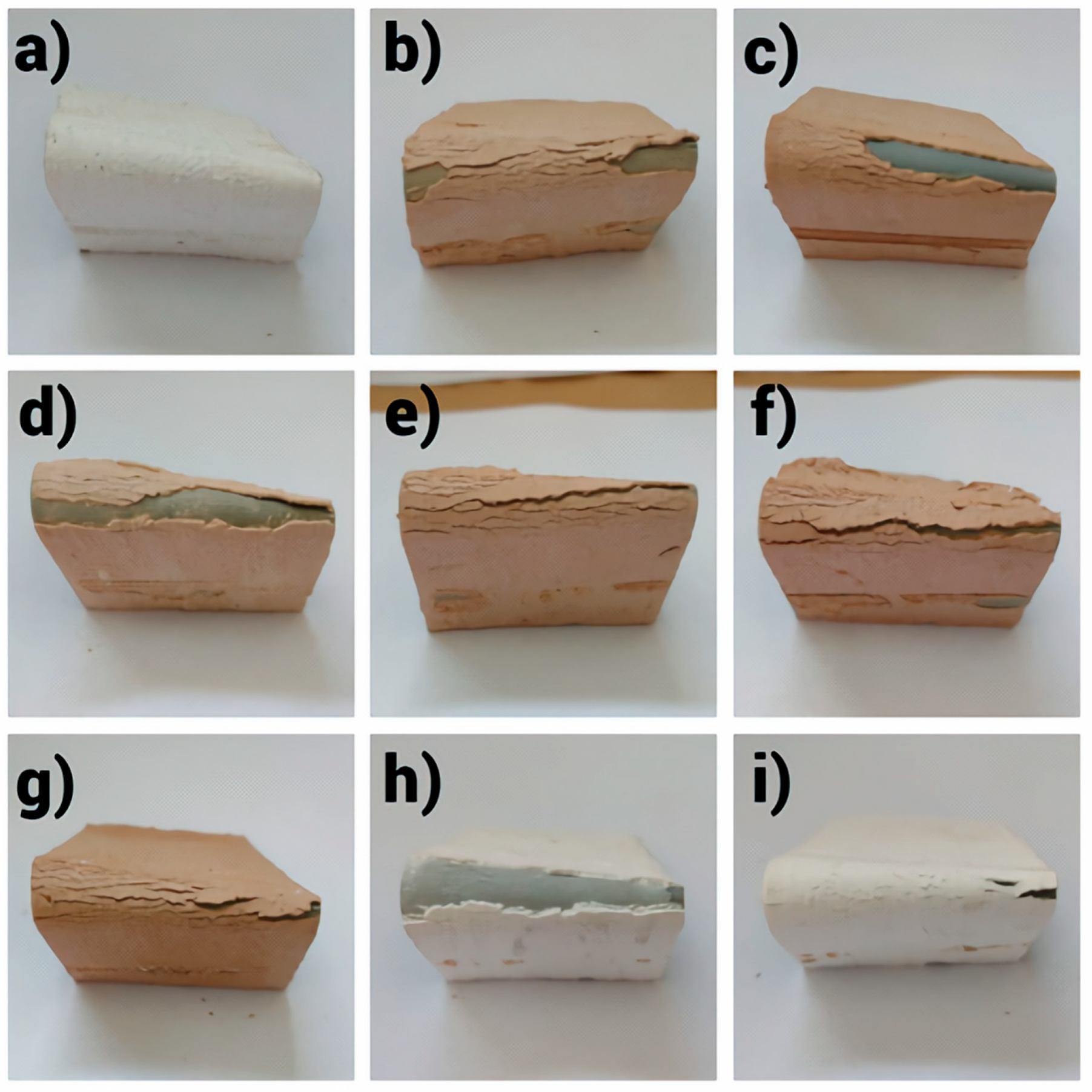
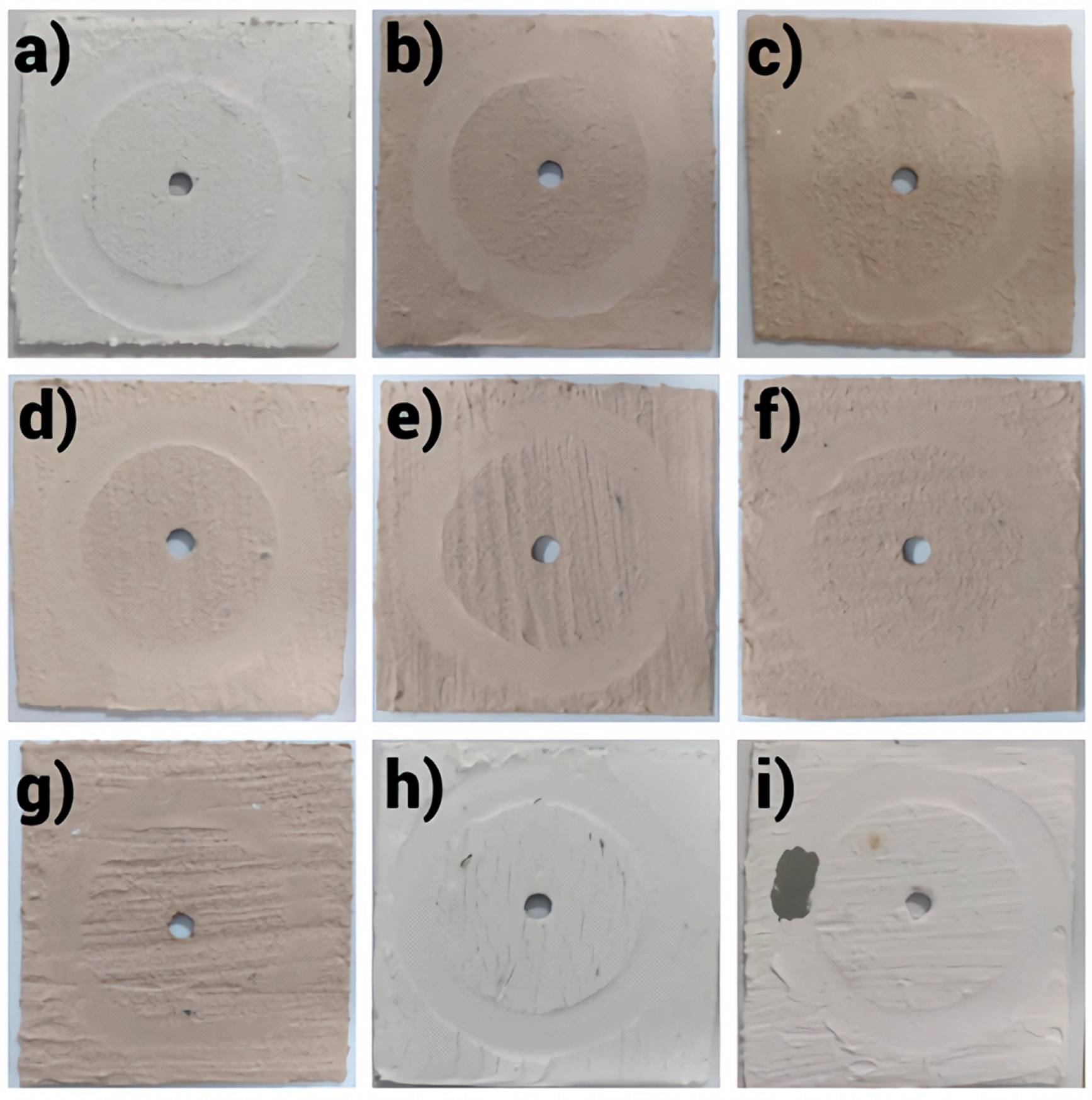

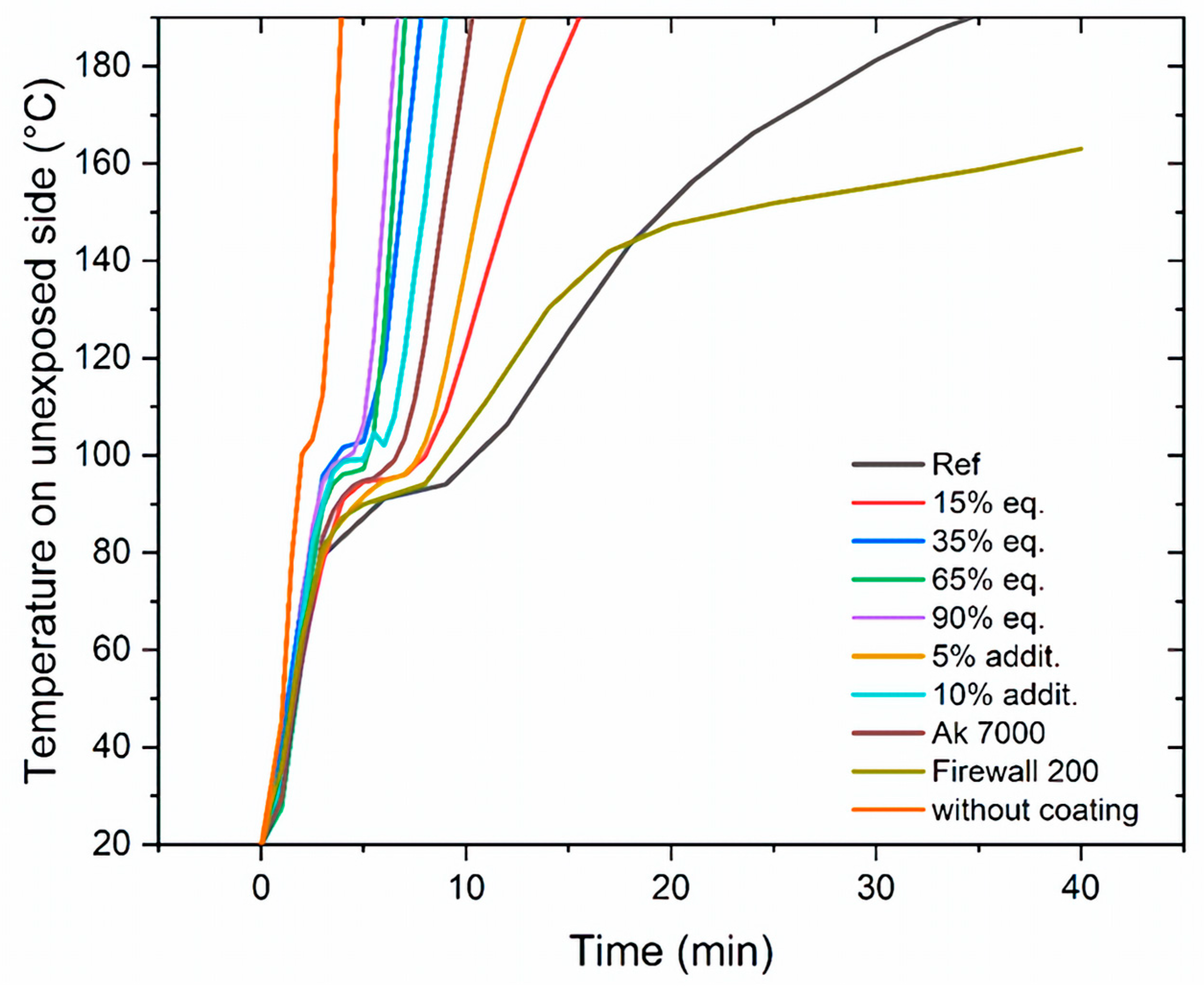
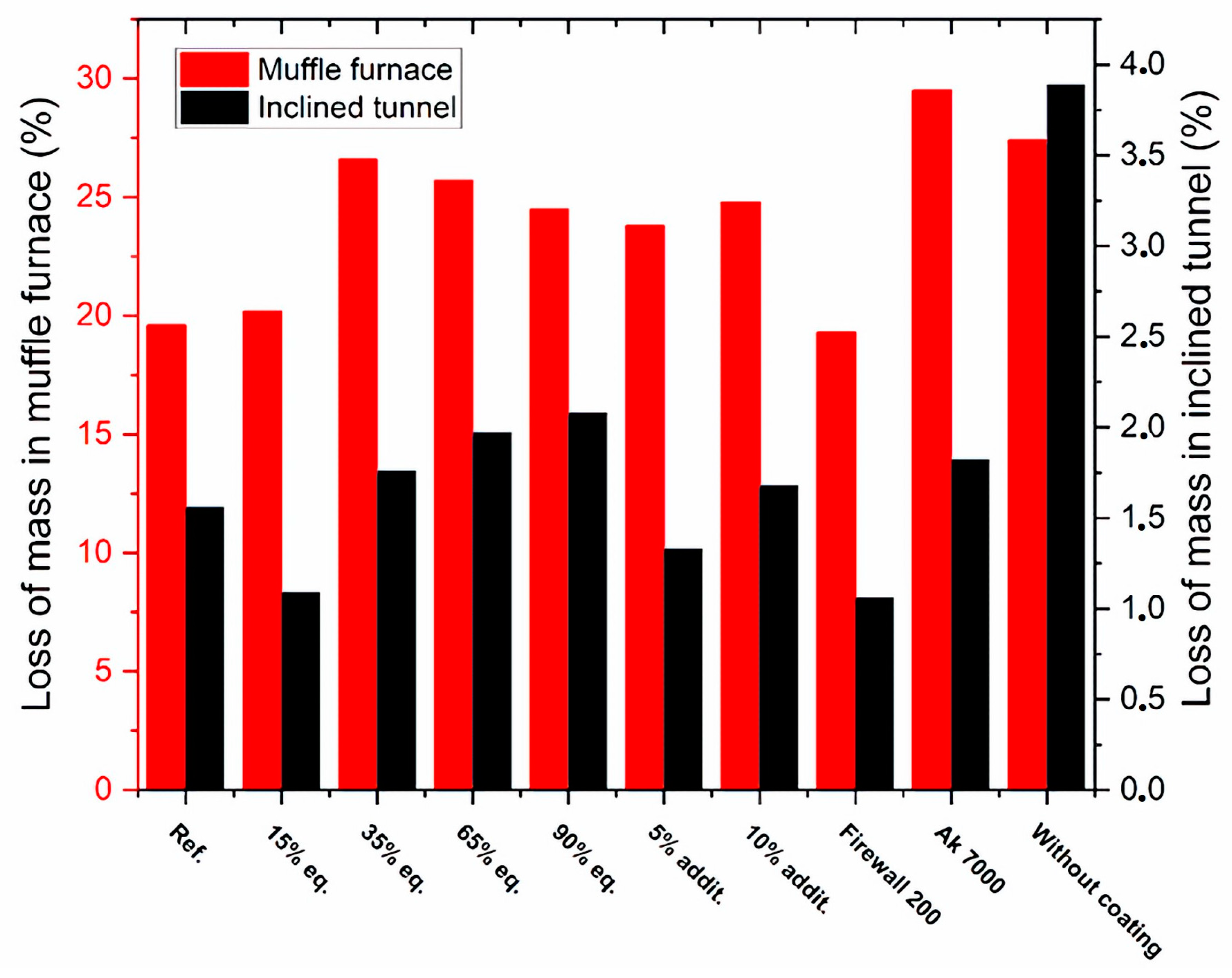
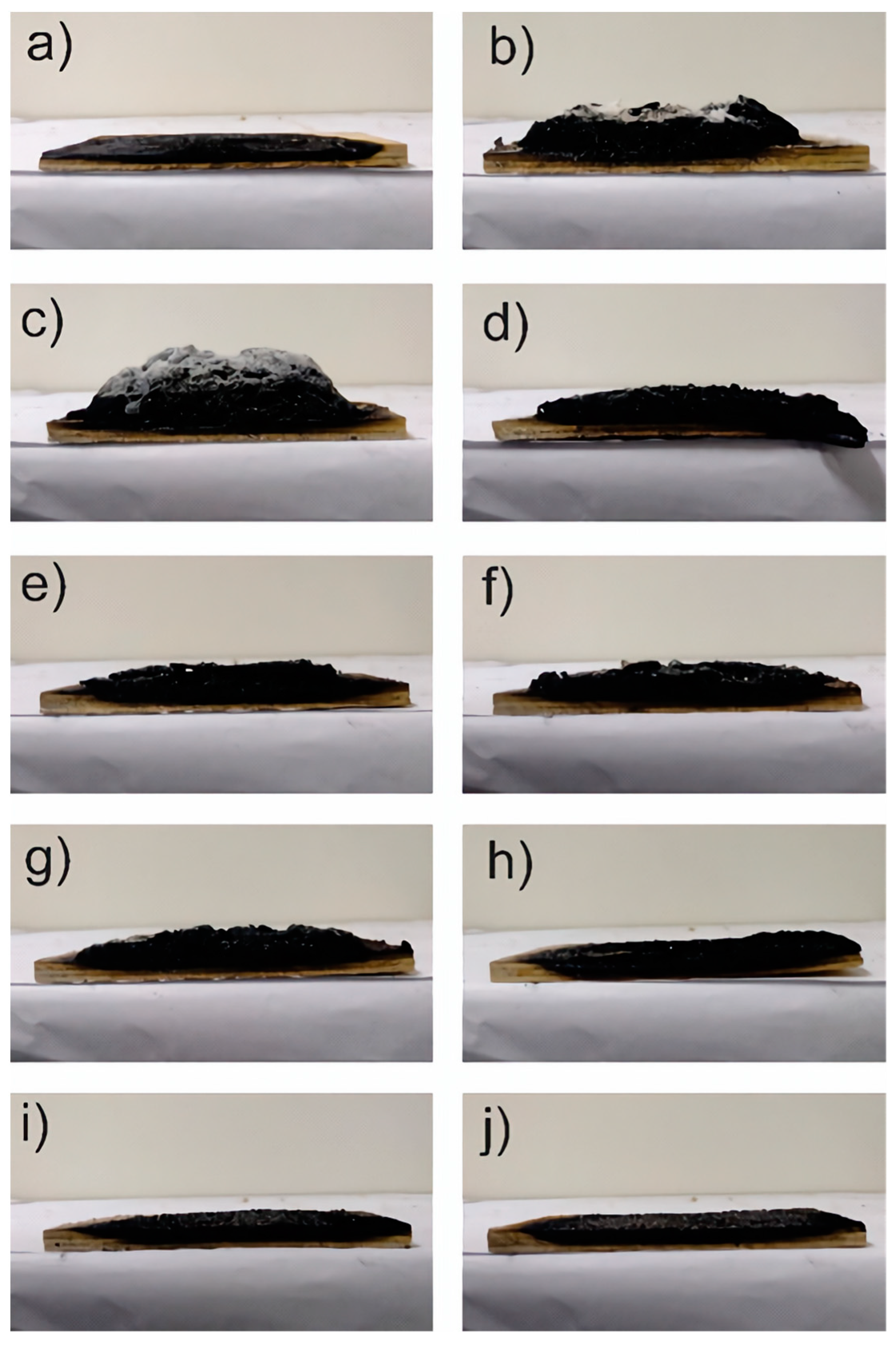

| Raw Material (%w/w) | Ref. | 15% Eq. | 35% Eq. | 65% Eq. | 90% Eq. | 5% Addit. | 10% Addit. |
|---|---|---|---|---|---|---|---|
| Water | 17.6 | 17.8 | 17.5 | 17.2 | 17.0 | 17.0 | 16.7 |
| Sodium polyacrylate | 1.5 | 1.5 | 1.5 | 1.5 | 1.5 | 1.5 | 1.5 |
| Dowanol DPBN | 1.6 | 1.6 | 1.6 | 1.6 | 1.6 | 1.6 | 1.6 |
| Technical Propylene Glycol | 1.3 | 1.3 | 1.3 | 1.3 | 1.3 | 1.3 | 1.3 |
| Proclear 756 | 0.2 | 0.2 | 0.2 | 0.2 | 0.2 | 0.2 | 0.2 |
| Soluble Tannin | 0.0 | 2.7 | 6.9 | 10.7 | 14.3 | 5.0 | 10 |
| Titanium Dioxide | 7.8 | 7.8 | 7.8 | 7.8 | 7.8 | 7.8 | 7.8 |
| Nonyl Phenol | 1.5 | 1.7 | 2.0 | 2.3 | 2.5 | 2.0 | 2.3 |
| Pentaerythritol | 10 | 8.4 | 5.7 | 3.2 | 0.9 | 9.0 | 7.8 |
| Melamine | 9.2 | 9.0 | 8.6 | 8.3 | 7.9 | 8.1 | 7.1 |
| Monoammonium Phosphate | 25.6 | 25.2 | 24.1 | 23.1 | 22.2 | 22.7 | 19.9 |
| Mowilith DM 230 | 23.4 | 22.6 | 22.6 | 22.6 | 22.6 | 23.4 | 23.4 |
| Proxel 109 | 0.2 | 0.2 | 0.2 | 0.2 | 0.2 | 0.2 | 0.2 |
| Total | 100 | 100 | 100 | 100 | 100 | 100 | 100 |
| Sample | Number of Hydroxide |
|---|---|
| Ref | - |
| LMW Tannin | 558.20 |
| HMW Tannin | 224.20 |
| Pentaerythritol | 1014.0 |
| Pentaerythritol/HMW Tannin ratio | 4.52 |
| Pentaerythritol/LMW Tannin ratio | 1.82 |
| Materials | Sample Mass (g) | Oil Absorption (%) |
|---|---|---|
| LMW Tannin | 1.25 | 109.0 |
| HMW Tannin | 1.02 | 55.0 |
| Formulation | Maximum Stress (MPa) | Failure Type | % Fracture |
|---|---|---|---|
| Ref. | 0.50 | Cohesive | 80 |
| 15% Eq. | 0.52 | Cohesive | 75 |
| 35% Eq. | 0.57 | Cohesive | 91 |
| 65% Eq. | 0.82 | Cohesive | 90 |
| 90% Eq. | 0.84 | Cohesive | 81 |
| 5% Addit. | 0.49 | Cohesive | 80 |
| 10% Addit. | 0.63 | Cohesive | 76 |
| Firewall 200 | 0.50 | Cohesive | 60 |
| Ak 7000 | 0.79 | Cohesive | 80 |
Disclaimer/Publisher’s Note: The statements, opinions and data contained in all publications are solely those of the individual author(s) and contributor(s) and not of MDPI and/or the editor(s). MDPI and/or the editor(s) disclaim responsibility for any injury to people or property resulting from any ideas, methods, instructions or products referred to in the content. |
© 2024 by the authors. Licensee MDPI, Basel, Switzerland. This article is an open access article distributed under the terms and conditions of the Creative Commons Attribution (CC BY) license (https://creativecommons.org/licenses/by/4.0/).
Share and Cite
Montoya, L.F.; Flores, J.; Ramírez, J.; Rojas, D.; Oñate, Á.; Fernández, K.; Jaramillo, A.F.; Miranda, C.; Melendrez, M.F. New Sustainable Intumescent Coating Based on Polyphenols Obtained from Wood Industry Waste. Coatings 2024, 14, 1004. https://doi.org/10.3390/coatings14081004
Montoya LF, Flores J, Ramírez J, Rojas D, Oñate Á, Fernández K, Jaramillo AF, Miranda C, Melendrez MF. New Sustainable Intumescent Coating Based on Polyphenols Obtained from Wood Industry Waste. Coatings. 2024; 14(8):1004. https://doi.org/10.3390/coatings14081004
Chicago/Turabian StyleMontoya, Luis F., Julio Flores, Jesús Ramírez, David Rojas, Ángelo Oñate, Katherina Fernández, Andrés F. Jaramillo, Cristian Miranda, and Manuel F. Melendrez. 2024. "New Sustainable Intumescent Coating Based on Polyphenols Obtained from Wood Industry Waste" Coatings 14, no. 8: 1004. https://doi.org/10.3390/coatings14081004






